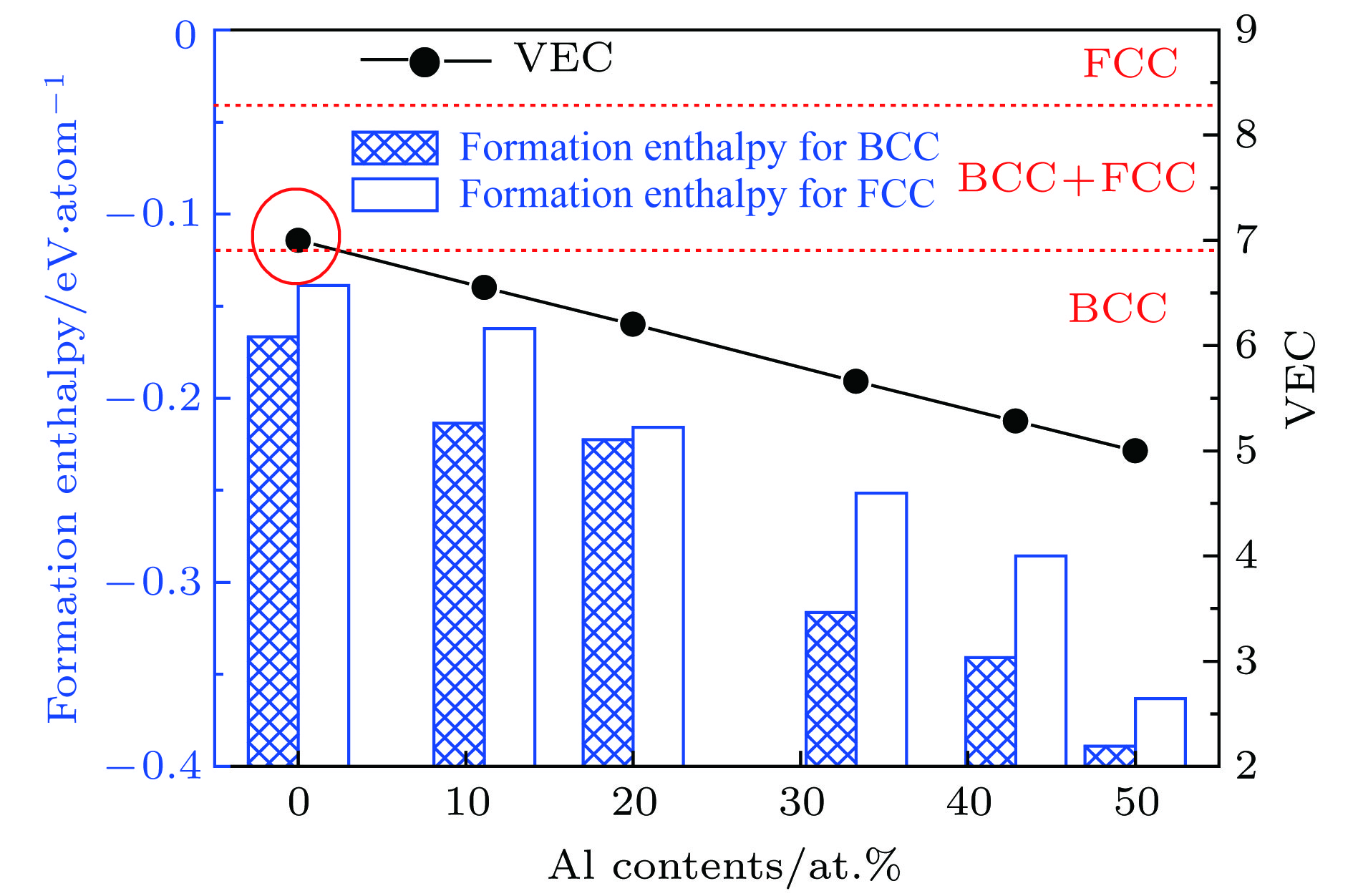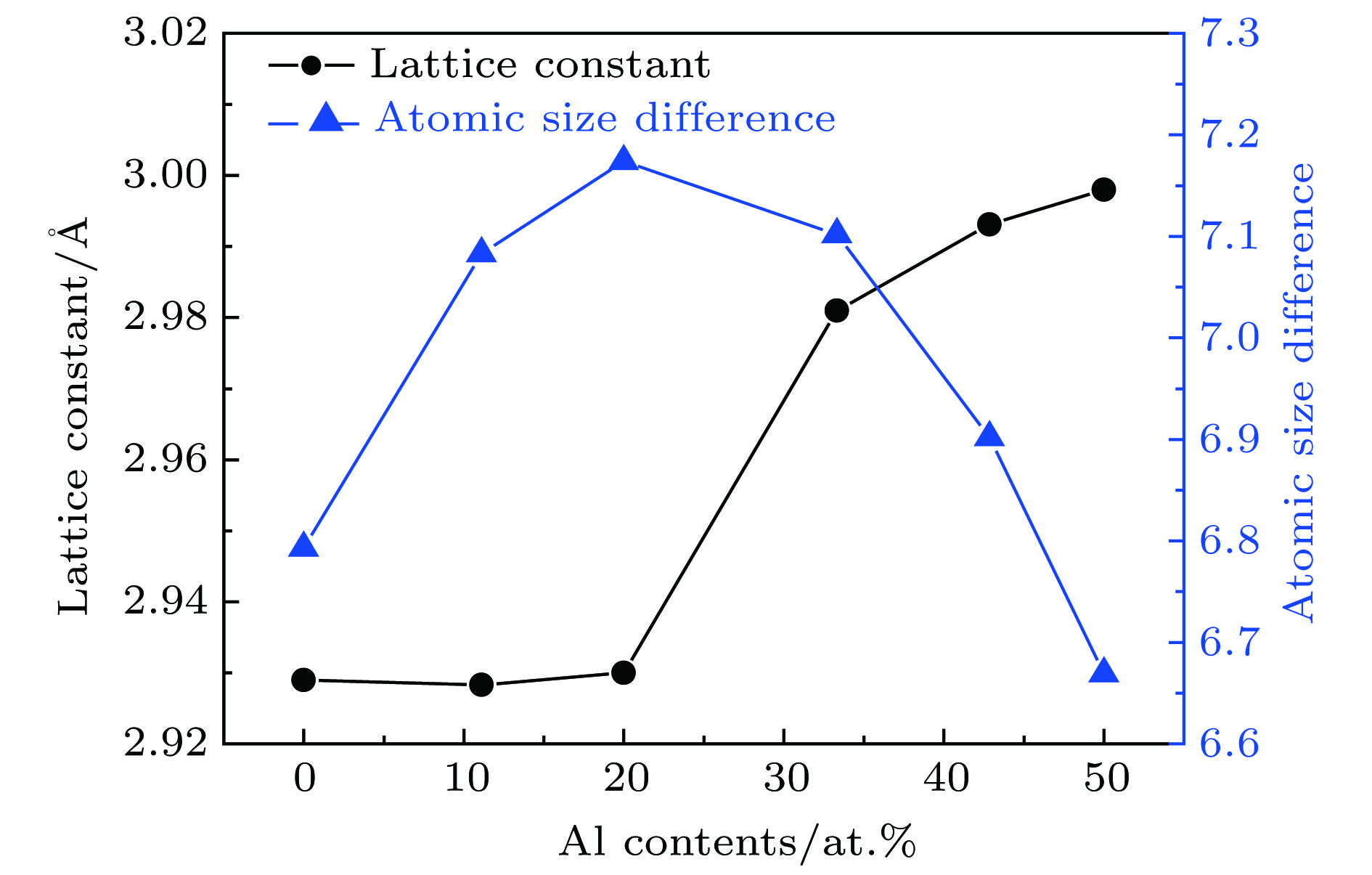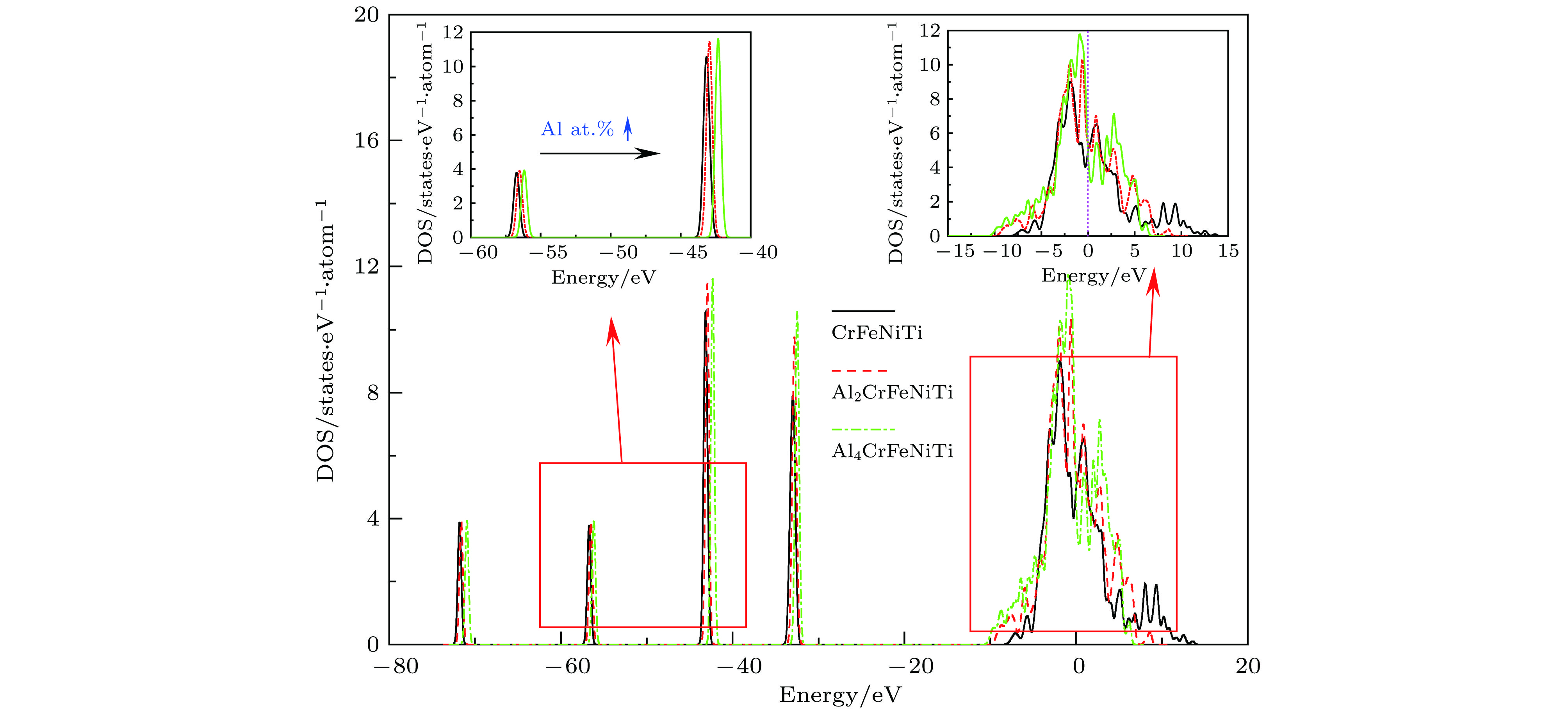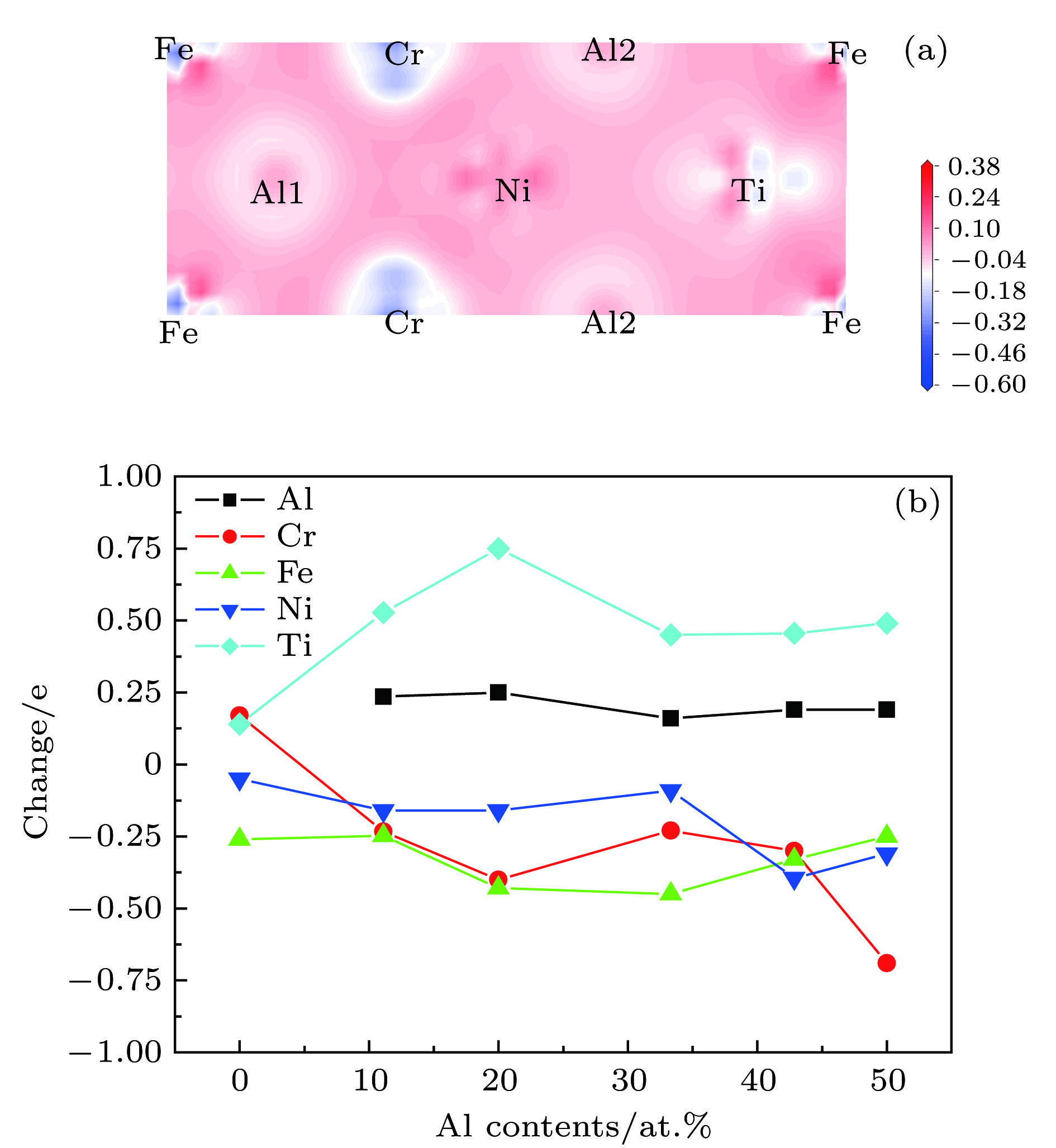-
为了探索AlxCrFeNiTi系高熵合金组成成分和弹性性质的关系, 结合固溶体特征参数和第一性原理计算, 研究Al元素含量对AlxCrFeNiTi (x = 0, 0.5, 1, 2, 3, 4)合金结构和弹性性质的影响, 并分析合金固溶体特征参数与弹性性质之间的关系. 结果表明: AlxCrFeNiTi系合金的价电子浓度随着Al含量的增加逐渐减小, 合金在体心立方结构下的形成焓均低于面心立方结构, 说明研究的AlxCrFeNiTi系合金会形成单一的体心立方结构固溶体; 合金的晶格常数和形成能力强弱随着Al含量的增加而增大, 但合金的结构稳定性略有下降; 当合金元素按照等原子比进行成分配比时, 合金的原子尺寸差异最大; AlxCrFeNiTi系合金中不同原子之间除了金属键结合外, 还表现出一定的共价和离子键结合特征; 对于AlxCrFeNiTi系合金而言, 随着热力学熵焓比的增大, 合金体弹模量和韧性随之增大; 随着合金混合焓的增加, 合金在压缩方向的各向异性程度明显降低. 热力学熵焓比和混合焓可作为AlxCrFeNiTi系高熵合金成分设计的重要参数.
-
关键词:
- AlxCrFeNiTi系高熵合金 /
- 第一性原理计算 /
- 固溶体特征参数 /
- 弹性性质
The effects of Al content on structure and elastic properties of AlxCrFeNiTi (x = 0, 0.5, 1, 2, 3, 4), and elastic properties varying with solid solution characteristic parameters of alloys are investigated in this work to explore the relationships between compositions and elastic properties of AlxCrFeNiTi high entropy alloys. The results show that the valence electron concentrations of AlxCrFeNiTi alloys decrease gradually with the increase of Al content, and the enthalpy formed by alloy with body center cubic structure is lower than that with face center cubic structure when Al content of the alloy is the same. It implies that AlxCrFeNiTi alloy will form a single solid solution with body centered cubic structure by referring to valence electron concentration theory and formation enthalpy calculation. The lattice constants and formation capacities of AlxCrFeNiTi alloys increase with Al content rising, while the structure stability of alloys presents a gradual downward trend. The atomic size difference shows the largest value when all elements in the alloy have equal molar ratio, indicating that the lattice distortion of the alloy exhibits the highest level at this time. The total state of density of AlxCrFeNiTi alloy moves to a higher energy level as the content of Al increases, which is an obvious characteristic of the declining structural stability of alloys. It is consistent with the result of cohesive energy. Al and Ti both lose electrons after bonding, while Ni and Fe both gain electrons. The bonding behavior between atoms shows not only metal bonding but also somewhat covalent and ionic bonding characteristics by analyzing the electron density difference and atomic Mulliken populations of AlxCrFeNiTi alloys. The elastic modulus and toughness of alloy will be improved with the increase of the ratio of thermodynamic entropy to enthalpy ($\varOmega $ ), and the anisotropy in compression direction of alloy decreases obviously with the rise of mixing enthalpy (ΔHmix). The solid solution characteristics including$\varOmega $ and ΔHmix will be used as important parameters for the compositions’ design for AlxCrFeNiTi alloy.-
Keywords:
- AlxCrFeNiTi high entropy alloys /
- first principle calculations /
- solid solution characteristics /
- elastic properties
[1] Yeh J W, Chen S K, Lin S J, Gan J Y, Chin T S, Shun T T, Tsau C H, Chang S Y 2004 Adv. Eng. Mater. 6 299
 Google Scholar
Google Scholar
[2] Miracle D B, Senkov O N 2017 Acta Mater. 122 448
 Google Scholar
Google Scholar
[3] Gludovatz B, Hohenwarter A, Catoor D, Chang E H, George E P, Ritchie R O 2014 Science 345 1153
 Google Scholar
Google Scholar
[4] Tsai M H, Yeh J W 2014 Mater. Res. Lett. 2 107
 Google Scholar
Google Scholar
[5] Senkov O N, Miller J D, Miracle D B, Woodward C 2015 Nat. Commun. 6 6529
 Google Scholar
Google Scholar
[6] Chuang M H, Tsai M H, Wang W R, Lin S J, Yeh J W 2011 Acta Mater. 59 6308
 Google Scholar
Google Scholar
[7] Dong Y, Zhou K, Lu Y P, Gao X X, Wang T M, Li T J 2014 Mater. Des. 57 67
 Google Scholar
Google Scholar
[8] Nong Z S, Zhu J C, Zhao R D 2017 Intermetallics 86 134
 Google Scholar
Google Scholar
[9] 刘瑞文 2018 硕士学位论文 (山东: 山东农业大学)
Liu R W 2018 M. S. Thesis (Shandong: Shandong Agricultural University) (in Chinese)
[10] Zhang Y, Yang X 2012 Mater. Chem. Phys. 132 233
 Google Scholar
Google Scholar
[11] Tian F Y, Varga L K, Chen N X, Shen J, Vitos L 2014 J. Alloys Compd. 599 19
 Google Scholar
Google Scholar
[12] Zhang Y, Zhou Y J, Lin J P, Chen G L, Liaw P K 2008 Adv. Eng. Mater. 10 534
 Google Scholar
Google Scholar
[13] 张章, 熊贤仲, 乙姣姣, 李金富 2013 物理学报 62 136401
 Google Scholar
Google Scholar
Zhang Z, Xiong X Z, Yi J J, Li J F 2013 Acta Phys. Sin. 62 136401
 Google Scholar
Google Scholar
[14] Massalaski T B 2010 Mater. Trans. 51 583
 Google Scholar
Google Scholar
[15] Guo S, Ng C, Lu J, Liu C T 2011 J. Appl. Phys. 109 103505
 Google Scholar
Google Scholar
[16] Marlo M, Milman V 2000 Phys. Rev. B 62 2899
 Google Scholar
Google Scholar
[17] Yao H Z, Ouyang L Z, Ching W Y 2007 J. Am. Ceram. Soc. 90 3194
 Google Scholar
Google Scholar
[18] Hao X F, Xu Y H, Wu Z J, Zhou D F, Liu X J, Meng J 2008 J. Alloys Compd. 453 413
 Google Scholar
Google Scholar
[19] Sahu B R 1997 Mater. Sci. Eng. B 49 74
 Google Scholar
Google Scholar
[20] Broyden C G, Dennis J E, Moré J J 1973 J. Appl. Math. 12 223
 Google Scholar
Google Scholar
[21] Sui Y W, Gao S, Chen X, Qi J Q, Yang F, Wei F X, He Y Z 2017 Vacuum 144 80
 Google Scholar
Google Scholar
[22] Segall M D, Shah R, Pickard C J, Payne M C 1996 Phys. Rev. B 54 16317
 Google Scholar
Google Scholar
[23] 范开敏, 杨莉, 孙庆强, 代云雅, 彭述明, 龙兴贵, 周晓松, 祖小涛 2013 物理学报 62 116201
 Google Scholar
Google Scholar
Fan K M, Yang L, Sun Q Q, Dai Y Y, Peng S M, Long X G, Zhou X S, Zu X T 2013 Acta Phys. Sin. 62 116201
 Google Scholar
Google Scholar
[24] Born M, Huang K 1954 Dynamical Theory of Crystal Lattices (Oxford: Oxford University Press) p10
[25] Nye J F 1985 Physical Properties of Crystals (Oxford: Oxford University Press) p113
-
图 1 Al含量对AlxCrFeNiTi系合金的VEC、形成焓和结构的影响, 其中当x = 0, 0.5, 1, 2, 3, 4时, 分别对应Al含量的原子百分比为0, 11.11 at.%, 20 at.%, 33.33 at.%, 42.86 at.%, 50 at.%
Fig. 1. Effect of Al contents on valence electron concentration, formation enthalpy and structure of AlxCrFeNiTi alloys. When x = 0, 0.5, 1, 2, 3, 4, the atomic percentages corresponding to Al content are 0, 11.11 at.%, 20 at.%, 33.33 at.%, 42.86 at.%, 50 at.% respectively.
图 7 AlxCrFeNiTi系合金固溶体特征参数和弹性性质之间的关系 (a) 热力学熵焓比
$\varOmega $ 与B, G, E, B/G的关系; (b) 混合焓$ \Delta H_{\rm mix}$ 与AG, AB的关系Fig. 7. Correlativity between solid solution characteristics and elastic properties of AlxCrFeNiTi alloys: (a) Ratio of thermodynamic entropy to enthalpy and B, G, E, B/G; (b) formation entahlpy
$ \Delta H_{\rm mix}$ and AG, AB.表 1 AlxCrFeNiTi系合金中元素的物理参数[15]
Table 1. Physical parameters of alloying elements in AlxCrFeNiTi alloys[15].
元素 原子半径/Å VEC 熔点Tm/℃ Al 1.432 3 660.2 Cr 1.249 6 1857 Fe 1.241 8 1535 Ni 1.246 10 1453 Ti 1.462 4 1660 表 2 不同Al含量下AlxCrFeNiTi系合金的弹性常数Cij
Table 2. Elastic constant Cij (in GPa) of AlxCrFeNiTi alloys with different Al contents.
合金 弹性常数Cij/GPa C11 C12 C13 C22 C23 C33 C44 C55 C66 CrFeNiTi 276.1 158.8 158.8 276.1 158.8 274.4 46.1 46.1 95.0 Al0.5CrFeNiTi 233.3 173.6 136.1 233.3 136.1 246.5 87.1 87.1 102.9 AlCrFeNiTi 198.1 139.3 139.3 198.1 139.3 218.1 90.3 90.3 91.5 Al2CrFeNiTi 158.3 118.4 118.4 158.3 118.4 245.8 75.7 75.7 80.7 Al3CrFeNiTi 191.6 124.9 130.4 191.6 130.4 148.2 104.6 104.6 77.3 Al4CrFeNiTi 213.4 91.6 91.6 213.4 91.6 207.1 99.8 99.8 106.9 -
[1] Yeh J W, Chen S K, Lin S J, Gan J Y, Chin T S, Shun T T, Tsau C H, Chang S Y 2004 Adv. Eng. Mater. 6 299
 Google Scholar
Google Scholar
[2] Miracle D B, Senkov O N 2017 Acta Mater. 122 448
 Google Scholar
Google Scholar
[3] Gludovatz B, Hohenwarter A, Catoor D, Chang E H, George E P, Ritchie R O 2014 Science 345 1153
 Google Scholar
Google Scholar
[4] Tsai M H, Yeh J W 2014 Mater. Res. Lett. 2 107
 Google Scholar
Google Scholar
[5] Senkov O N, Miller J D, Miracle D B, Woodward C 2015 Nat. Commun. 6 6529
 Google Scholar
Google Scholar
[6] Chuang M H, Tsai M H, Wang W R, Lin S J, Yeh J W 2011 Acta Mater. 59 6308
 Google Scholar
Google Scholar
[7] Dong Y, Zhou K, Lu Y P, Gao X X, Wang T M, Li T J 2014 Mater. Des. 57 67
 Google Scholar
Google Scholar
[8] Nong Z S, Zhu J C, Zhao R D 2017 Intermetallics 86 134
 Google Scholar
Google Scholar
[9] 刘瑞文 2018 硕士学位论文 (山东: 山东农业大学)
Liu R W 2018 M. S. Thesis (Shandong: Shandong Agricultural University) (in Chinese)
[10] Zhang Y, Yang X 2012 Mater. Chem. Phys. 132 233
 Google Scholar
Google Scholar
[11] Tian F Y, Varga L K, Chen N X, Shen J, Vitos L 2014 J. Alloys Compd. 599 19
 Google Scholar
Google Scholar
[12] Zhang Y, Zhou Y J, Lin J P, Chen G L, Liaw P K 2008 Adv. Eng. Mater. 10 534
 Google Scholar
Google Scholar
[13] 张章, 熊贤仲, 乙姣姣, 李金富 2013 物理学报 62 136401
 Google Scholar
Google Scholar
Zhang Z, Xiong X Z, Yi J J, Li J F 2013 Acta Phys. Sin. 62 136401
 Google Scholar
Google Scholar
[14] Massalaski T B 2010 Mater. Trans. 51 583
 Google Scholar
Google Scholar
[15] Guo S, Ng C, Lu J, Liu C T 2011 J. Appl. Phys. 109 103505
 Google Scholar
Google Scholar
[16] Marlo M, Milman V 2000 Phys. Rev. B 62 2899
 Google Scholar
Google Scholar
[17] Yao H Z, Ouyang L Z, Ching W Y 2007 J. Am. Ceram. Soc. 90 3194
 Google Scholar
Google Scholar
[18] Hao X F, Xu Y H, Wu Z J, Zhou D F, Liu X J, Meng J 2008 J. Alloys Compd. 453 413
 Google Scholar
Google Scholar
[19] Sahu B R 1997 Mater. Sci. Eng. B 49 74
 Google Scholar
Google Scholar
[20] Broyden C G, Dennis J E, Moré J J 1973 J. Appl. Math. 12 223
 Google Scholar
Google Scholar
[21] Sui Y W, Gao S, Chen X, Qi J Q, Yang F, Wei F X, He Y Z 2017 Vacuum 144 80
 Google Scholar
Google Scholar
[22] Segall M D, Shah R, Pickard C J, Payne M C 1996 Phys. Rev. B 54 16317
 Google Scholar
Google Scholar
[23] 范开敏, 杨莉, 孙庆强, 代云雅, 彭述明, 龙兴贵, 周晓松, 祖小涛 2013 物理学报 62 116201
 Google Scholar
Google Scholar
Fan K M, Yang L, Sun Q Q, Dai Y Y, Peng S M, Long X G, Zhou X S, Zu X T 2013 Acta Phys. Sin. 62 116201
 Google Scholar
Google Scholar
[24] Born M, Huang K 1954 Dynamical Theory of Crystal Lattices (Oxford: Oxford University Press) p10
[25] Nye J F 1985 Physical Properties of Crystals (Oxford: Oxford University Press) p113
计量
- 文章访问数: 17197
- PDF下载量: 185
- 被引次数: 0















 下载:
下载:












